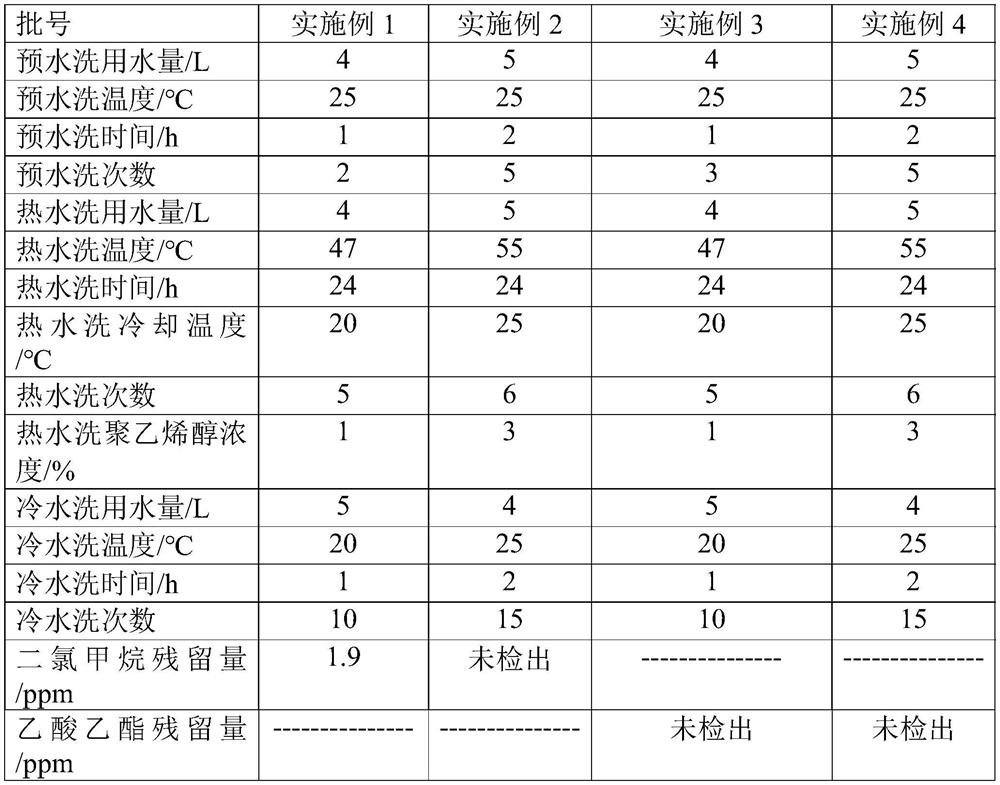Method for removing residual organic solvent in polymer microsphere solvent
A technology of organic solvents and polymers, applied in the medical field, can solve the problems of high residual organic solvents and the influence of microsphere shape, etc., and achieve the effect of reducing the residual amount, accelerating the transfer amount and transfer speed
- Summary
- Abstract
- Description
- Claims
- Application Information
AI Technical Summary
Problems solved by technology
Method used
Image
Examples
Embodiment 1
[0031] A method for removing organic solvent residues from polymer microsphere solvents, comprising the following steps:
[0032] Step S01, using dichloromethane as an organic solvent, the raw materials are polylactic acid, polyglycolic acid, polycaprolactone, poly (lactate - hydroxyacetic acid) copolymer of any one; Organic solvents and raw materials are configured into a mixture of prepared polymer microspheres;
[0033] Step S02, microsphere pre-washing: Transfer the configured polymer microsphere mixture to a beaker of 5 L, add 4 L of purified water, stir at 500 rpm at 25 °C for 1 h to transfer the organic solvent in the solution to water, centrifuge and discard the supernatant after washing, collect the microspheres, repeat the water washing process 2 times;
[0034] Step S03, microsphere hot water washing: then add 4L of purified water to the pre-washed polymer microspheres, and then add a certain concentration of anti-aggregation agent solution, anti-aggregation agent using...
Embodiment 2
[0038] A method for removing organic solvent residues from polymer microsphere solvents, comprising the following steps:
[0039] Step S01, using dichloromethane as an organic solvent, the raw materials are polylactic acid, polyglycolic acid, polycaprolactone, poly (lactate - hydroxyacetic acid) copolymer of any one; Organic solvents and raw materials are configured into a mixture of prepared polymer microspheres;
[0040] Step S02, microsphere pre-washing: Transfer the emulsified polymer microsphere mixture to a beaker of 5 L, add 5 L of purified water, stir at 500 rpm at 25 °C for 2h to transfer the organic solvent in the solution to water, centrifuge and discard the supernatant after the end of the wash, collect the microspheres, and repeat the pre-wash process 5 times.
[0041] Step S03, microsphere hot water washing: add 5L of purified water to the washed polymer microspheres, and then add a certain concentration of anti-aggregation agent solution, anti-aggregation agent usin...
Embodiment 3
[0046] A method for removing organic solvent residues from polymer microsphere solvents, comprising the following steps:
[0047] Step S01, ethyl acetate is used as an organic solvent, and the raw material is a poly (lactate - hydroxyacetic acid) copolymer; Organic solvents and raw materials are configured into a mixture of prepared polymer microspheres;
[0048] Step S02, microsphere pre-washing: Transfer the emulsified polymer microsphere mixture to a beaker of 5 L, add 4 L of purified water, stir at 500 rpm at 25 °C for 1h to transfer the organic solvent in the solution to water, centrifuge and discard the supernatant after the end of the wash, collect the beads, and repeat the pre-wash process 3 times.
[0049] Step S03, microsphere hot water washing: then add 4L of purified water to the pre-washed polymer microspheres, and then add a certain concentration of anti-aggregation agent solution, anti-aggregation agent using polyvinyl alcohol, formulated into 1% polyvinyl alcohol sol...
PUM
 Login to View More
Login to View More Abstract
Description
Claims
Application Information
 Login to View More
Login to View More - R&D
- Intellectual Property
- Life Sciences
- Materials
- Tech Scout
- Unparalleled Data Quality
- Higher Quality Content
- 60% Fewer Hallucinations
Browse by: Latest US Patents, China's latest patents, Technical Efficacy Thesaurus, Application Domain, Technology Topic, Popular Technical Reports.
© 2025 PatSnap. All rights reserved.Legal|Privacy policy|Modern Slavery Act Transparency Statement|Sitemap|About US| Contact US: help@patsnap.com

